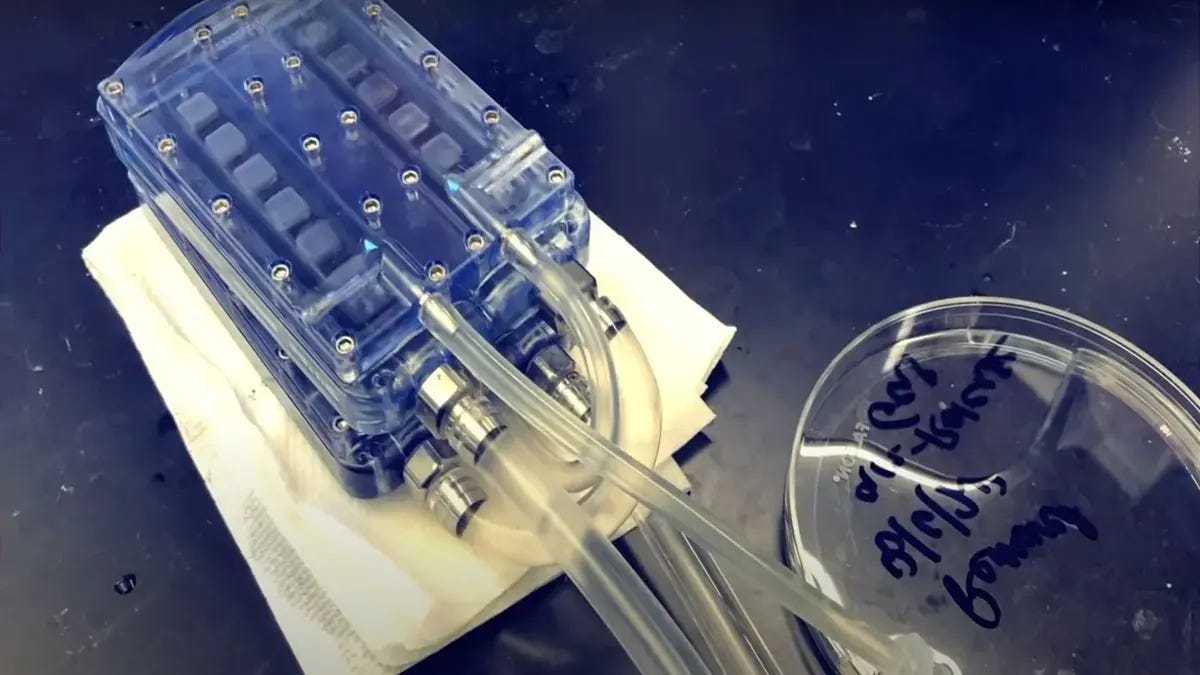Sci-Ed Update 292
Graph literacy, swirling brain activity, AI & killer viruses, Merkel cell carcinoma, eponyms & more on no eponyms, is the artificial kidney ready? ...and more!
Graph Literacy
Here are two brief videos from Visible Body that help students with graphing literacy. These are basic concepts and skill sets that all our A&P students need before they can even begin to understand our course content.
Graphing Literacy: How to read a graph and interpret data
Graphing Literacy: Bell curves and error bars
What to Know About Merkel Cell Carcinoma, the Rare Cancer that Killed Jimmy Buffett
"Margaritaville" singer Jimmy Buffett died of Merkel cell carcinoma, a rare but aggressive form of skin cancer, according to a tribute posted on his official website.
Merkel cell carcinoma often resembles other forms of skin cancer, and a biopsy indicating the diagnosis can be surprising given how rare cases are, Madan said.
In fact, there are only around 2,000 cases of Merkel cell carcinoma diagnosed in the U.S. each year, according to the American Cancer Society. As for the most common forms of skin cancer, there are some 5.4 million basal and squamous cell skin cancers diagnosed each year in about 3.3 million Americans.
Merkel cell carcinoma starts when cells in the skin -- known as Merkel cells for the German doctor Friedrich Merkel who first described them -- begin to grow out of control.
Merkel cells are "thought to be a type of skin neuroendocrine cell, because they share some features with nerve cells and hormone-making cells," according to the American Cancer Society. Merkel cell carcinoma "tends to grow quickly and can be hard to treat if it spreads beyond the skin."
Kevin Patton comment→ Merkel cell carcinoma is often called simply MCC. I am trying to eliminate the use of anatomic eponyms in my teaching and writing, so I call the involved cells tactile epithelial cells instead of Merkel cells. If you want more details on MCC than the overview from MedPage Today quoted above and linked below, try this scientific review article: AandP.info/cjv
Read more→ AandP.info/vaq
The Eponym Episodes
Below are two episodes from The A&P Professor podcast regarding the use of eponyms (terms named for someone) in A&P. For example, an eponym historically (and still today) used in place of tactile epithelial cell is Merkel cell. The second episode below includes a follow-up to the first episode listed.
The Eponym Episode | Using Modern Terminology
To listen to this episode, click on the player (if present) or this link→ theAPprofessor.org/podcast-episode-40.html
More on Eponyms in A&P Terminology
To listen to this episode, click on the player (if present) or this link→ theAPprofessor.org/podcast-episode-41.html
Former Google Exec Warns AI Could Create a Deadly Plague
An AI pioneer and former Google executive has issued a stark warning about the technology he helped unleash upon the world — and this one's bound to go, well, viral.
"The darkest scenario is that people will experiment with pathogens, engineered synthetic pathogens that might end up accidentally or intentionally being more transmissible," said Google DeepMind co-founder Mustafa Suleyman in a recent episode of "The Diary of a CEO" podcast.
AI-manipulated viruses could "spread faster or [be] more lethal," Suleyman said, ultimately causing "more harm" and potentially even killing people "like a pandemic."
"We are working with dangerous things," he continued. "We can't let just anyone have access to them. We need to limit who can use the AI software, the cloud systems, and even some of the biological materials."
With more and more people learning how to use the technology than ever before, there's little to stop anybody from genetically engineering a viral pathogen worse than anything ever seen before and unleashing it onto the world – which is why the DeepMind co-founder is advocating for a "containment" strategy on AI similar to the one NATO has in place for nukes.
"We have to limit access to the tools," Suleyman said, "and the know-how to carry out that kind of experimentation."
Kevin Patton comment→ Good grief. Just when I was starting to get over the feeling that we’re living through a real-life adaptation of a science-fiction disaster movie!
Read more→ AandP.info/40q
The Missing Link in Cognitive Processing? Scientists Discover Swirling Spirals in the Brain

Scientists from the University of Sydney and Fudan University have found human brain signals traveling across the outer layer of neural tissue that naturally arrange themselves to resemble swirling spirals.
Published in the journal Nature Human Behaviour, the study suggests that these widespread spiral patterns, seen during both rest and cognitive activity, play a role in organizing brain function and cognitive processes.
Senior author Associate Professor Pulin Gong, from the School of Physics in the Faculty of Science, said the discovery could have the potential to advance powerful computing machines inspired by the intricate workings of the human brain.
Kevin Patton comment→ I kinda always pictured my brain as having swirls of activity. Now I’m thinking maybe that’s a good thing. I’ll just let that thought swirl around in my head a bit more.
Read more→ AandP.info/5zi
Blood Clotting Proteins Might Help Predict Long COVID Brain Fog

Many people who have long COVID—a condition in which health issues persist months after infection—report struggling with “brain fog,” recurring memory and concentration lapses that make it difficult to function in everyday life. Now a new study has found these cognitive problems could result from blood clots triggered by infection, possibly through mechanisms like those that cause some types of dementia. These clots leave telltale protein signatures in blood, suggesting that testing for them could help predict, diagnose and possibly even treat long COVID.
The findings, published on Thursday in Nature Medicine, suggest that existing blood tests for detecting these proteins could help physicians recognize long COVID (although some experts caution that long COVID’s symptoms and causes likely vary among individuals). Up to 15 percent of people who contract SARS-CoV-2, the virus that causes COVID, go on to develop long COVID symptoms that can last for months or years. The condition has proved difficult to treat—or even diagnose—because of the mishmash of reported symptoms such as brain fog, fatigue, respiratory problems and numerous other effects. It’s still unclear whether the virus sticks around in the body or the initial infection triggers another reaction, such as an autoimmune response, that leads to the continuing symptoms.
Read more→ AandP.info/z8r
Artificial kidney is a success in pigs, what about humans?
There is a severe shortage of kidney donors in the US. About 92,000 patients on the national transplant waiting list seek a kidney, and due to kidney failure, more than half a million patients have to undergo dialysis many times a week.
Out of these patients, only about 20,000 can secure kidneys from donors in a year. The situation is even worse in many underdeveloped countries.
To solve such challenges related to kidney transplants, two scientists,, Dr. Shuvo Roy, a bioengineering expert from the University of California, San Francisco (UCSF), and Dr. William Fissell, a nephrologist at Vanderbilt University Medical Center, launched an initiative known as 'The Kidney Project' in the year 1998.
The project is still ongoing, and its goal is to develop a surgically implantable bioartificial kidney for humans who are living with kidney failure and are not able to find a donor.
In their latest study, Dr. Roy and his team demonstrated a device known as the bioreactor that works like an actual kidney when planted in pigs. “For the first time, kidney cells housed in an implantable device called a bioreactor can survive inside the body of a pig and mimic several important kidney functions,” the researchers note.
Read more→ AandP.info/833







